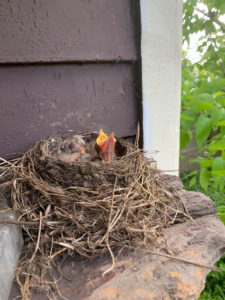 Not all sweet stories have happy endings. Take the one I wrote last week about the baby robins born on my daughter Leigh’s back porch. Before that column saw print, I got bad news. Horrible news, in fact.
Not all sweet stories have happy endings. Take the one I wrote last week about the baby robins born on my daughter Leigh’s back porch. Before that column saw print, I got bad news. Horrible news, in fact.
A predator had found the nest. None of the baby birds survived.
The happy tears I cried when Leigh texted that the eggs had hatched were nothing compared to the tears I shed when I learned the babies were dead. Leigh and Matt get up early in the morning, most times long before their children awake. As had been their habit ever since the robin parents began nesting outside their back door, they flipped on the porch light to see how things were going. That’s when they discovered the carnage.
“Luckily, we saw the wreckage in time for Matt to clean it up,” Leigh texted. “We told the kids that the robins flew away.” Six-year-old June inspected the floor of the stoop and said, “Well, yes, they must have flown because I don’t see any dead birds on the ground.”
So at least the ending was happy for those young enough not to know how savage life can be, especially if you’re a baby bird. Only one in four young robins survive to adulthood. I don’t know if those statistics hold true for other bird species, but I suspect they’re not too different.
Almost 20 years ago, I wrote a column about a killdeer mother who laid her eggs in the middle of a walking path next to the Cookeville High School tennis courts. Killdeers are “precocial” birds, which means the babies are able to scamper about and search for food within minutes after hatching, though I still think that busy path was a crazy place for the mama to lay eggs. The same isn’t true for “altricial” birds like robins, whose babies are hatched blind, naked and completely helpless. It’s a wonder any of them survive.
When my kids were little, our family moved to an old farm on Cherry Creek Road. A wise friend who’d spent her whole life in the country advised me not to try to hide the hard truths of birth and death from my children. “Farm kids get tough quick,” she said. “They have to.”
Yet it broke my heart when my children discovered a dead piglet our dog had dragged from the neighbor’s mud hole onto our front porch. They saw with their own eyes what a coyote can do to a newborn calf. They discovered a massacred litter of barn kittens before I had a chance to bury them. And, yeah, they watched a five-foot-long black snake devour a nest full of baby barn swallows.
Life can be cruel. And very, very short, especially for baby animals.
We’ll likely never know what kind of predator got Leigh’s robins. It could have been a cat or a raccoon or even another species of bird. What really hurts about this sad story, in addition to the fact that I learned about it right after I e-mailed last week’s happy baby robin story to my Herald-Citizen editors, is how invested Leigh was in those birds. She took dozens of pictures, from the day the eggs appeared in the nest all the way up to what was to be the babies’ last day. She was fascinated at how they poked their little beaks up toward the sky, begging to be fed. She marveled at how the robin parents tirelessly took care of their children. She counted down the days until take-off.
And then she put on her game face and told her own kids a little white lie so that their hearts wouldn’t break along with hers. It’s what good mothers do. But that doesn’t mean it’s easy.
(May 22, 2021)